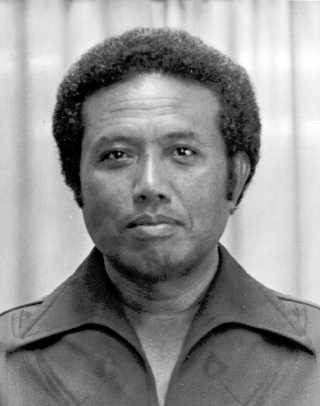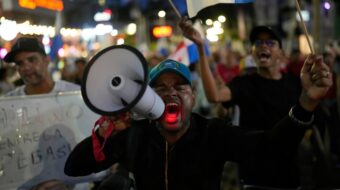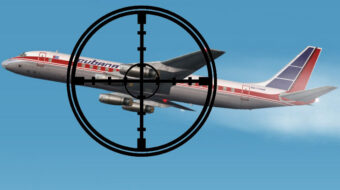
On June 30, 1985, 30 years ago today, Haruo Remeliik, the president of anti-nuclear Palau, had his brains blown out. What – if anything – did former CIA Director George H.W. Bush have to do with this and what does it say about who the Bushes really are?
Last December, as Jeb Bush prepared for his presidential bid, reports about his financial dealings revealed that, according to the L.A. Times: “Bush and his partners also set up two other funds. BH Logistics raised $26 million and invested it in Dorian LPG Ltd., a shipping company incorporated last year in the Marshall Islands to transport propane gas.” While Politico noted that BH Logistics is involved in the shale oil industry, a more intriguing point is: Why has Jeb Bush been connected to the remote Republic of the Marshall Islands, site of numerous postwar U.S. hydrogen and atomic bomb tests?
In fact, Bush dynasty involvement in Micronesia – those Western Pacific Islands roughly stretching between Hawaii and the Philippines – dates back to World War II’s Pacific Theater campaign. It is a sordid saga of terrorism against peace and eco-activists, including presidential assassinations, primarily aimed at destroying Oceania’s 1980s environmental movement, from Moruroa to Auckland to Koror and beyond.
On July 25, 1944, fighter pilot George Herbert Walker Bush’s plane sank a Japanese trawler at Kayangel atoll, the northernmost tip of what is now the Republic of Palau, in Micronesia. Interestingly, according to a 1993 cover story in Harper‘s Magazine, after Bush’s plane sank the Japanese ship, survivors in two lifeboats were strafed, a violation of international law. Decades later, when Mark Hertsgaard of Harper‘s asked Bush’s Houston office if Bush had committed this war crime, the response was: “No comment.” (This story was suppressed until after the 1992 election, although much was made of Clinton’s draft record. In the 1991 Gulf War, while George H.W. Bush was commander-in-chief, U.S. forces repeatedly killed Iraqis after they fled and/or surrendered.)
From September to November 1944, the Battle of Peleliu raged in southern Palau, and was one of the bloodiest conflicts during WWII’s island hopping campaign, costing the Marines and Navy 6,526 casualties. As a very young man, Navy pilot Bush had impressed upon him the strategic importance and value of this island chain that stretches across vital Australia/Japan/Indonesia shipping lanes in the southwestern Pacific. George H.W. Bush’s mysterious connections to Palau continued while he was CIA Director, Vice President and President.
After the U.S. conquered Palau, Washington administered the far-flung archipelago as part of the United Nations Trust Territory of the Pacific Islands from 1947 to the 1990s. Following WWII, America agreed to a sacred trust: to develop Micronesia so it could eventually exercise a legitimate act of self-determination via a plebiscite, with voters freely voting on the islands’ future political status. However, Washington recognized the military value of this 3 million square mile area stretching between Hawaii and the Philippines (with Palau as its southwestern tier), and it became the only Strategic Trust of the 11 U.N. trusteeships.
The Defense Department used the Marshall Islands as a nuclear test site from 1946-1958, and in the 1970s, as Palau prepared for self-rule, concerned about nuclear fallout and irradiation, a super-majority of Palauans passed a nuclear-free constitution. However, this clashed with Pentagon policy to neither confirm nor deny that its crafts are nuclear-powered or -armed, plus DOD plans to relocate U.S. forward bases from the Philippines to Micronesia. The conflict came to a head while George H.W. Bush, veteran of WWII’s Palau campaign, was CIA Director and in the Executive Branch.
The not so pacific Pacific
According to Bob Woodward in The Washington Post, CIA chief G.H.W. Bush presided over illegal bugging of Micronesian political status negotiations in the 1970s, ordered by Henry Kissinger, carried out by Bush ally Brent Scowcroft, and aimed at “exerting covert influence on key elements of the Micronesian independence movement.” While Vice President, Bush had his longtime crony Fred Zeder, an ex-Pacific fighter pilot and Texas businessman, appointed the President’s personal representative for Micronesian status negotiations in 1982.
Zeder had been admitted to the Young Presidents’ Organization in 1960 at the University of Michigan, where his roommate was Prescott S. Bush Jr., the brother of George Bush Sr. While he was chairman and CEO of the diversified manufacturing company Hydrometals Corporation, Zeder moved the firm from New York to Dallas in the early 1960s. Zeder was elected to the City Council in Dallas in 1971 and also served on the Dallas-Fort Worth Regional Airport Board. His business interest in the Pacific Islands is evinced by the fact that he was chairman of the board of Paradise Cruise Corporation in Hawaii from 1978 to his death in 2004.
Zeder played a role in bankrupting tiny Palau by supporting IPSECO – an apparent covert action disguised as a power plant, with generators and a fuel farm far too big for Palau’s 15,000 people (but large enough to provide power/fuel for future possible U.S. military bases). The only way the emerging nation could pay off its enormous power debt was by approving a treaty called the Compact of Free Association. The accord would nullify Palau’s anti-nuclear constitution – in exchange for U.S. aid.
Much was made about “regime change” in Iraq because of Saddam’s purported weapons of mass destruction. But scant attention has been paid to the tragic tale of regime change in a Pacific Island of 15,000 indigenous people who dared oppose U.S. WMDs – and the Bush connection to Palau. George W. Bush may ballyhoo the notion of spreading democracy, but while his father was in the executive branch, Palauans were compelled to vote about 15 times in around as many years on self-rule and their nuclear-free status. Palauans could vote, but their vote didn’t count unless it favored U.S. policy. Palauans had to keep casting their ballots until Washington attained its desired result: the rescinding of the anti-nuclear clauses of Palau’s constitution.
During this display of democracy, Palau was gripped by a mysterious reign of terror. On June 30, 1985, Pres. Haruo Remeliik was assassinated, which reopened the then-deadlocked treaty negotiations. Shortly after the liquidation, then-Vice Pres. Bush personally flew to Saipan, where the Trust Territory administration was headquartered, to reopen stalled negotiations, and struck a new deal.
However, antinuclear activists defeated the treaty in court, where the Palau High Court ruled that a 75 percent vote in favor of a proposed Compact of Free Association was required in order to override the tiny nation’s anti-nuclear laws. In 1987, terrorists firebombed and shot Pacific pacifists, and besieged Palau’s congress. A U.S. Congressional General Accounting Office investigation found a $2 million U.S.-derived slush fund that financed political violence. In 1988, Palau’s second elected president, pro-U.S. puppet Lazarus Salii, also mysteriously had his head blown off. Although this was officially declared a suicide, the elimination of Salii – who was unable to pass the Compact – untied the Gordian knot that led to the elimination of Palau’s anti-nuclear clauses.
Other high ranking U.S. officials during the Reagan-Bush era who had links to Palau include: Secretary of State George Shultz, who secured Palauan beachheads as a Marine sergeant during WWII. Shultz returned to Palau in 1986 during the Compact re-negotiation process. In the late 1970s, Admiral William Crowe surveyed land in Palau for U.S. bases, and became CINCPAC (Commander in Chief, Pacific Command) and Joint Chiefs of Staff Chairman 1985-1989. President George H.W. Bush appointed Brent Scowcroft – who’d arranged the Kissinger-ordered surveillance of Micronesian status negotiations – National Security Adviser.
Remembering the Rainbow Warrior
Paris was Washington’s colonial partner in Oceania, and in the 1960s Moruroa, in French-occupied Polynesia, became France’s South Pacific nuclear testing site for atmospheric and underwater N-blasts. Ten days before French secret agents bombed the Rainbow Warrior in antinuclear New Zealand (July 10, 1985), as Greenpeace prepared to protest France’s nuclear testing near Tahiti, the first president of the world’s first national nuclear-free zone was gunned down. Saboteurs of the Rainbow Warrior were captured and convicted, and the implicated chiefs of France’s military and intelligence services resigned. It’s an established fact that French state terrorism was responsible for the Greenpeace ship bombing. Is it farfetched to think the assassination of two of Palau’s presidents and the reign of terror there constituted American state terrorism?
As former CIA chief, George H.W. Bush headed what LBJ called “Murder, Inc.,” and, as mobsters say: “The fish stinks from the head down.” The Pentagon had motive: relocating bases from the Philippines (closed after Marcos’ overthrow) to Palau – thwarted by the world’s first nuclear-free constitution. To find out who commits a crime, see who benefits from it: The IPSECO debt and political violence finally wore Palauans down, and in the 1990s their antinuclear framed rules were defeated. Palau was, in effect, annexed by Uncle Sam, as was the rest of Micronesia.
The story of Palau is full of irony and a case study in U.S. imperial rule and Bush governance. During the Iraq War, the beaten-into-submission islands joined the so-called “coalition of the willing.” Washington claimed it invaded Iraq and brought about regime change because of its purported WMDs. On the other hand, regime change happened in nuclear-free Palau because it refused to allow actually existing WMDs to transit its waters and skies or on its land. The second Bush administration cited Iraqi ties to Al–Qaeda and international terrorism as another (subsequently debunked) rationale for war, but when tiny Palau dared resist Washington’s will, a real reign of terror was unleashed on the island nation that included the mysterious gunshot deaths of its first two elected presidents. Although Bush II purports that spreading democracy was another reason for invading Iraq, Palauans were forced to keep going to the polls until the outcome of a vote was finally deemed acceptable to the White House.
And all this took place while somebody named George Bush – senior, then junior – was in the executive branch. Now, another member of this ruling-class family – which puts the “nasty” into dynasty – is seeking the White House. As Jeb Bush’s idiotic Iraq War comments made while he was on the campaign trail in May indicate, along with his choice of Bush regime-era advisers, the apple doesn’t fall far from the foreign policy tree. (As Donald Trump pithily put it after Jeb’s Iraq blundering: “Is he intelligent?”) And as Jeb’s business dealings in the Marshalls reveal, he too has interests in islands which suffered so much while his father was CIA chief, vice president and president, destroying the world’s first national nuclear-free zone.
Thirty years after the assassination of Palau’s president (and the bombing of Greenpeace’s Rainbow Warrior), voters need to know about and take into account the Bushes’ real role in the Pacific. With another Bush running for the White House, it’s time for the news media to get serious and to investigate whether Bush Sr. was involved in Haruo Remeliik’s assassination – and exactly who the Bushes really are and how they do business.
Ed Rampell covered Palau during Bush‘s vice presidency for AP, Reuters, Newsweek, Radio New Zealand, Radio Australia, Gannett Press, Pacific Islands Monthly, etc. He initiated and was the investigative reporter for ABC News‘ “20/20“ segment, “The Puzzle of Palau,“ which aired in July 1987 and proved that three young men related to the opposition leader who were convicted of assassinating President Remeliik were framed political prisoners. Within two weeks of the Barbara Walters-introduced report, the trio was fully exonerated of the murder by Palau‘s Supreme Court. Rampell went on to report for the Australian Broadcasting Corp.‘s Background Briefing two-part exposé that directly resulted in the conviction of Palau‘s pro-Washington Minister of State for soliciting the homicide of President Remeliik.
Photo: Haruo Ignacio Remeliik by TTPI(Trust Territory of the Pacific Islands) Headquarters – Trust Territory of the Pacific Islands Archives Photograph Collection. Licensed under Public Domain via Wikimedia Commons-.










